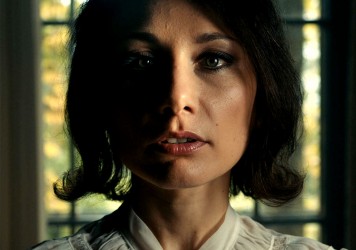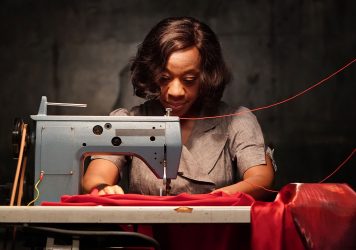
The cult British writer/director discusses his surreal sartorial horror yarn, In Fabric.
In Fabric is Peter Strickland’s darkly comic horror tale about a possessed dress and the lives it affects. Marianne Jean-Baptiste plays Sheila, a bank clerk looking for love who buys the ill-starred garment from oddball department store Dentley and Soper. She finds herself in a real-life costume drama, quite aside from putting up with her amorous son Vince (Simon Manyonda) and his domineering girlfriend Gwen (Gwendoline Christie).
The writer/director’s previous film, The Duke of Burgundy, is an intriguingly strange and beautifully delivered study of desire and devotion. Once again he tackles sex and love from an unusual perspective and here explains how his very own phantom thread got made with inspiration from mannequins, Mel Gibson and The Office.
LWLies: You’ve made a film about a haunted dress. What inspired the idea?
Strickland: I think this idea that all clothing is haunted by a human presence. People think you can’t make a film about an object but I can guarantee you can reduce anyone to tears if you gave them a dead relative’s clothing. How clothing can make you grieve, how clothing can turn you on, how clothing can disgust you. And also how we feel when we wear clothing, how you can transform, how your posture changes, how your expression changes and the opposite of that: how you can hate your body when you wear something, how you can have body dysmorphia. It’s exploring ideas about fetishism, loss. I remember buying second-hand corduroy trousers which had a come stain on them. The idea of, ‘My god there’s a whole history’.
Did you wear them?
I washed them first. It’s also charity shops: clothing marked by sweat and bodily fluids and dead people’s clothing. The film is opening up a discussion about how we perceive clothing. There’s a very light satire on consumerism in the background. I don’t want be earnest or righteous about it because I’m sure there’s something I’m wearing now which was made in a sweatshop, so I’m a hypocrite to go down that path.
It looks like it’s set in the 1980s. Is there a reason you focused on that time?
It’s 1983 – there’s a newspaper front page which has it discreetly hidden. I wanted it to feel like the ’70s, maybe because department stores always had that look. Ideally I would have set it now but if I did that the whole dating thing would have been very different with Tinder and swiping. What I wanted was the mystery of dating back then. You had to imagine what a person’s like.
On one level the film does feel like a satire of retail. Do you have a particular affection for those stores?
I love the world of those stores, I love the flamboyance, I love the heightened theatrical nature of those stores. It’s a celebration as much as a parody. All of that is dying out. I love that human interaction. It’s a performance. I remember this store in Reading [where Strickland grew up] called Jackson’s. It had the pneumatic chutes where the money flew up, so that long wait for your change to come back and that awkwardness while you’re standing there. I thought that would be so good to put in a film.
I was trying to really true to the way I saw the world as a kid, how the mannequins feel like they’re protecting the store, they’re guarding the store like they’re kind of agents in all this. And how interchangeable mannequins and the staff can be, the sound of people shopping, the movement of people shopping. The important thing was that everything had to be connected to reality. Everything is exaggerated but when I spoke to the actors everything was on a dial. Reality was, say, zero and complete surreality was, say, 10. It was really talking about it like that, like an elastic band stretching reality but without every breaking that elastic band.
What’s the fascination with washing machines about?
It’s clothing again, isn’t it? It’s all connected. I wanted to make an autonomous sensory meridian response (ASMR) film. A lot of the influences were those YouTube videos. It’s like this tactile response to certain sounds, like whispering, catalogue pages being turned, that kind of thing. I wanted to make a film you could fall asleep to. So it was very important to get the right paperweight for the catalogue, to make it thick enough to have that sound. I wanted to make a film of textures, physical textures and sonic textures, the texture of the human voice and send you into a bit of a trance.
There were certain key influences on your previous work: giallo films in Berberian Sound Studio and Stan Brakhage on parts of The Duke of Burgundy. Were there any particular inspirations for this film?
There was no big sensibility. Giallo really didn’t come into it at all. The big influence for me was beyond film, people like Keyholtz, the German sculptor. He did a lot of work with mannequins. Incredibly scary looking mannequins with resin dripping down their faces. Very nightmarish. When Mr Lundy gets the shoplifter in a leg-lock, that comes from the end of Lethal Weapon in the fight scene with Mel Gibson and the bad guy.
The Office was a huge influence. As a middle-class university graduate you end up in a lot of those white-collar jobs. The Office taught me that this is not a waste of time, this is all material you can use later on and if you use it without being self-pitying it can be very cathartic and people can relate to it. The Office was a huge revelation for me and was very inspiring. People want to hear if it was Chantal Akerman or something. I hate to say but television in 2000 was a big influence.
The portrayal of sex and desire in the film is very unusual. Can you shed any light on what you were thinking?
I guess clothing is sold on human desire. The whole commodification of desire, the catalogues, so it’s exploring that, for sure, but also beyond that going into to this parallel dimension of sex magick rituals of the mannequin being washed and menstruating. Is the dress made of menstrual blood? Is it acting as a dye? In terms of someone like Gwen and Vince and the underwear, it’s the element of showing clothing being erotic, it’s erotic because of the human imprint. And the scenes with Gwen, that’s more about accentuating Sheila’s loneliness. There’s nothing worse than hearing people in your house having fun when you’re not having fun.
In Fabric is released 28 June. Read the LWLies Recommends review.
Published 24 Jun 2019

Director Peter Strickland’s sumptuous, all-female S&M fable is his greatest film to date.

By Anton Bitel
Peter Strickland spins a yarn about a haunted dress in this fashionable freakout.

Despite its lesbian and lepidoptera themes, Peter Strickland’s relationship drama is anchored by universal truths about domestic role-play.